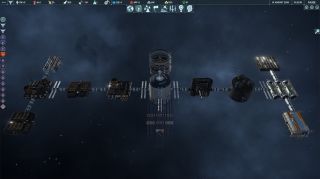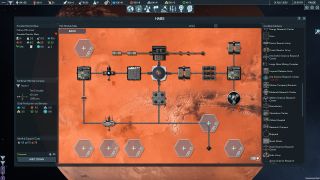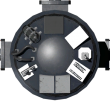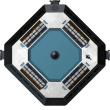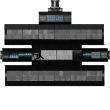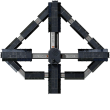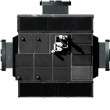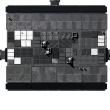Habs
Habitats, or habs, are space-based facilities operated by factions. They are composed of modules. All modules have a core module; the size of the core determines the size of the hab. The size of the hab determines both how many modules you can have (4, 12 or 20, plus the core), and the maximum size of each module.
Habs may be founded in three ways. One is to launch the core module from Earth, using boost. This can take a lot of time if the location is far from the homeworld. A second is to develop and build kits that ships can deploy when they arrive in an orbit or land on a space body. A third is to found habs from other habs in the same planetary system that have a construction module.
Habs may be assaulted and captured by Marines from ships, although building barracks modules helps defend it. A councilor with a high command attribute leading an assault mission gives it a much greater chance of success.
Habs, like fleets, belong directly to a faction. Your hab may be nominally operating under NASA or the United Nations, but what matters is that its people are really working for The Academy, The Resistance, Project Exodus, etc.
Stations
Stations are built in an orbit. When the game starts there are two existing tier 1 stations, each with a unique orbit around Earth: The International Space Station, with two Solar Collectors and one Space Science Lab, and Tiangong Station, with no modules beyond the core. A random faction will have control of each habitat.
Stations use the following core modules. They require the couuncil engineering project with the same name to be constructed.
Particle Colliders
Particle Colliders are used to produce antimatter. They also produce Energy Research but once the bonus goes above 50% it suffers diminishing returns.
Bases
Bases are built at a hab site. Hab sites are discovered by launching a prospector probe after the required technology has been researched.
Bases use the following core modules. They require the couuncil engineering project with the same name to be constructed.
Mining Complexes
Each base will have a Mining Deposit Access Point above the Core Module. Only Mining Complex modules can be constructed on it, which will produce the resources of the hab site. Its construction cost and power consumption scale with the escape velocity of the celestial body and its distance from Earth.
Modules
Most hab modules consume power. You must build sufficient power-generating modules to accommodate your other modules. Modules may be turned off to reduce power consumption, although certain modules must remain on if there is power to support them in the hab. Modules also have a maintenance cost in space resources, which can be paid with boost and money if sufficient space resources aren't available. Some modules also have a mission control cost, as well.
Hab modules are added to habs either by shipping them from Earth using boost or building them out of space materials. Some modules have upgrade paths to larger versions; upgrading a module in this way is done at a discount.
Many modules can be built both at stations and bases, although some are hab-type-specific. Most need a project completed to unlock them. A few are faction-specific. Several are upgrades of prior ones: The materials lab can become a materials research center, which can become a materials institute at the largest hab.
There are hab modules for research, hab modules for money and influence production, and hab modules that grant engineering project capacity. Most modules have a support cost, which is drawn from your space resources, if you have them, otherwise from your boost. And if you are out of both, or have insufficient mission control, your hab is much more likely to suffer accidents, and be much more willing to switch allegiance to another faction.
Four module types deserve further note:
- Supply Depots. These let your fleets take on propellant and reload weapons by drawing down your space resource supply, or boost. These can go on the smallest habs; we expect you’ll need a network of them around the Solar System to keep your fleets moving.
- Shipyards. These let you build and repair your warships. Larger yards speed construction of the ships. You’ll have a shipyard manager interface with build queues so you can coordinate construction across your holdings.
- Barracks. These hold Marines to defend your hab from enemy assaults. From stations in an interface orbit, the Marines can also drop to assault surface bases, as long as one of your councilors is present to lead them. Councilors can similarly lead Marine assaults from one of your bases against a nearby enemy base.
- Defense modules. These mount antiship and point defense weaponry for space combat. If a station is involved in combat, the enemy’s objective is to destroy these modules. After the battle, the station can be boarded or destroyed. Defense modules on bases fire back when the base is being bombarded form orbit.
List of all Hab Modules
Power Modules
| Module | Tier | Crew | Mass (tons) | Build Time (days) | Support Cost | Build Cost (from earth) | Build Cost (from space) | Requirements | Effect |
|---|---|---|---|---|---|---|---|---|---|
| Solar Panel | 1 | 30 |
| ||||||
| Solar Array | 2 | crew | mass | 60 | suport cost | build cost | buidl cot space |
| |
| Solar Farm | 3 | crew | mass | build time | suport cost | build cost | buidl cot space |
| |
| Fission Pile | 1 | crew | mass | 30 | suport cost | build cost | buidl cot space | Nuclear Fission in space |
|
| Fission Reactor Array | 2 | crew | mass | 60 | suport cost | build cost | buidl cot space | Nuclear Fission in space |
|
| Fission Reactor Farm | 3 | crew | mass | buildtime | suport cost | build cost | buidl cot space | Nuclear Fission in space |
|
| Automated Fission Pile | 1 | 0 | mass | 30 | suport cost | build cost | buidl cot space | Nuclear Fission in space
Advanced Neural Networks |
|
| Fusion Pile | 1 | crew | mass | time | suport cost | build cost | buidl cot space | Nuclear Fusion in space |
|
| Fusion Reactor Array | 2 | crew | mass | time | suport cost | build cost | buidl cot space | Nuclear Fusion in space |
|
| Fusion Reactor Farm | 3 | crew | mass | time | suport cost | build cost | buidl cot space | Nuclear Fusion in space |
|
Utility Modules
Science Modules
| Tier 1 | Tier 2 | Tier 3 | |||
|---|---|---|---|---|---|
| Module | Effects | Module | Effects | Module | Effects |
| Energy Lab | +3 Crew +5 Research +3% Energy Research -8 Power +3% Boost priority effect if in Earth orbit (max +30%) |
Energy Research Center | +25 Crew +10 Research +10% Energy Research -32 Power +6% Boost priority effect if in Earth orbit (max +30%) |
Energy Institute | +125 Crew +20 Research +25% Energy Research -96 Power +10% Boost priority effect if in Earth orbit (max +30%) |
| Information Science Lab | +3 Crew +5 Research +3% Information Science Research -6 Power +3% Knowledge priority effect if in Earth orbit (max +30%) |
Information Science Research Center | +25 Crew +10 Research +10% Information Science Research -24 Power +6% Knowledge priority effect if in Earth orbit (max +30%) |
Information Science Institute | +125 Crew +20 Research +25% Information Science Research -72 Power +10% Knowledge priority effect if in Earth orbit (max +30%) |
| Life Science Lab | +3 Crew +5 Research +3% Life Science Research -5 Power +3% Welfare priority effect if in Earth orbit (max +30%) |
Life Science Research Center | +25 Crew +10 Research +10% Life Science Research -20 Power +6% Welfare priority effect if in Earth orbit (max +30%) |
Life Science Institute | +125 Crew +20 Research +25% Life Science Research -60 Power +10% Welfare priority effect if in Earth orbit (max +30%) |
| Materials Lab | +3 Crew +5 Research +3% Materials Research -5 Power +3% Military priority effect if in Earth orbit (max +30%) |
Materials Research Center | +25 Crew +10 Research +10% Materials Research -20 Power +6% Military priority effect if in Earth orbit (max +30%) |
Materials Institute | +125 Crew +20 Research +25% Materials Research -60 Power +10% Military priority effect if in Earth orbit (max +30%) |
| Military Science Lab | +3 Crew +5 Research +3% Military Science Research -5 Power +0.03 Miltech if in Earth orbit (max +0.3) |
Military Science Research Center | +25 Crew +10 Research +10% Military Science Research -20 Power +0.06 Miltech if in Earth orbit (max +0.3) |
Military Science Institute | +125 Crew +20 Research +25% Military Science Research -60 Power +0.1 Miltech if in Earth orbit (max +0.3) |
| Space Science Lab | +3 Crew +5 Research +3% Space Science Research -5 Power +3% Mission Control priority effect if in Earth orbit (max +30%) |
Space Science Research Center | +25 Crew +10 Research +10% Space Science Research -20 Power +6% Mission Control priority effect if in Earth orbit (max +30%) |
Space Science Institute | +125 Crew +20 Research +25% Space Science Research -60 Power +10% Mission Control priority effect if in Earth orbit (max +30%) |
| Xenology Lab | +3 Crew +5 Research +10% Xenology Science Research -5 Power +1 Alien Detection if in Earth orbit (max +9) |
Xenoscience Research Center | +25 Crew +10 Research +25% Xenology Science Research -20 Power +2 Alien Detection if in Earth orbit (max +9) |
Xenoscience Institute | +125 Crew +20 Research +50% Xenology Science Research -60 Power +3 Alien Detection if in Earth orbit (max +9) |
Civilian Modules
Civilian Modules must be constructed either in stations in Earth orbit or on bases on celestial bodies with at leat 50000 population. They cannot be build in irradiated locations.
Councilor Missions
You can also send councilors to habs, either by spending boost to launch from Earth to somewhere in the Earth-Moon system, or by hitching a ride on a ship. Councilors may only board enemy human ships or the smallest habs if they have the “undercover” trait. But second- and third-tier habs are large enough that councilors may board freely.
Once aboard, councilors can run a number of missions, including sabotaging a particular module or persuading the hab’s leaders to switch sides and join your faction.
Finding the UI
Once you have the prerequisites of a Hab space station, deselect (click x) on any agents. Zoom out until the boarders and icons on Earth aren't shown. Then click on Earth, it will zoom in a bit and a small icon of a space station with a + will appear at the bottom where commands normally are.
 Hooded Horse Wikis
Hooded Horse Wikis